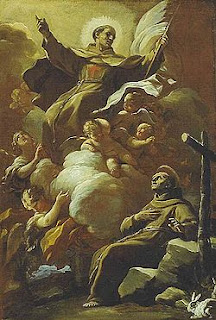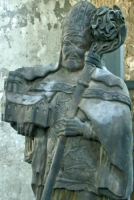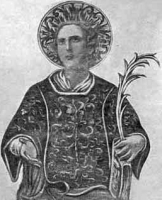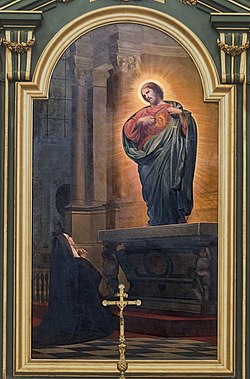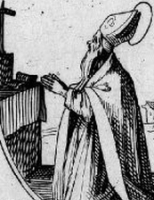Saint Luke the Evangelist
புனிதர் லூக்கா
திருத்தூதர், நற்செய்தியாளர், மறைசாட்சி:
அந்தியோக்கியா, சிரியா, ரோமப் பேரரசு
இறப்பு: கி.பி. சுமார் 84 (வயது 84)
பியோஷியா அருகே, கிரேக்கம்
ஏற்கும் சமயம்:
ரோமன் கத்தோலிக்க திருச்சபை
கிழக்கு மரபுவழி திருச்சபை
கிழக்கு கத்தோலிக்க திருச்சபை
ஆங்கிலிக்கன் ஒன்றியம்
ஓரியண்டல் மரபுவழி திருச்சபை
லூதரனியம் மற்றும் சில சீர்திருத்தத் திருச்சபைகள்
முக்கிய திருத்தலங்கள்:
பதுவை இத்தாலி
நினைவுத் திருவிழா: அக்டோபர் 18
பாதுகாவல்:
கலைஞர்கள், மருத்துவர்கள், விவசாயிகள்,
அறுவை சிகிச்சை மருத்துவர்கள் மற்றும் பலர்
குறிப்பிடத்தகுந்த படைப்புகள்:
லூக்கா நற்செய்தி
அப்போஸ்தலர் பணி
நற்செய்தியாளரான புனிதர் லூக்கா, ஒரு ஆதி கிறிஸ்தவ எழுத்தாளரும், திருச்சபை தந்தையரும், புனித ஜெரோம் மற்றும் யோசிபஸின்'படி விவிலியத்தின் லூக்கா நற்செய்தி மற்றும் அப்போஸ்தலர் பணி என்னும் நூல்களின் ஆசிரியரும் ஆவார். இவர் நான்கு நற்செய்தியாளர்களுள் ஒருவராகக் கருதப்படுகின்றார். இவரின் எழுத்து நடை, இவர் நன்கு கற்றறிந்தவர் என்பதனை எடுத்தியம்புகின்றது.
அந்தியோக்கியா நகரில் பிறந்து வாழ்ந்த இவர், தொழில்ரீதியாக ஒரு மருத்துவர் ஆவார். இவரைப்பற்றிய மிகப்பழைய குறிப்பு திருத்தூதர் பவுல் எழுதிய பிலமோன் வசனம் 24, கொலோசையர் 4:14 மற்றும் திமொத்தேயு 4:11ல் காணக்கிடைக்கின்றது.
இவர் இயேசுவின் பன்னிரு திருத்தூதர்களில் ஒருவர் அல்ல. மாறாக அவரின் 70 சீடருள் ஒருவராக இருக்கலாம் எனவும், குறிப்பாக உயிர்த்த இயேசுவோடு எமாவுசுக்கு சென்ற இரு சீடர்களுள் ஒருவராக இருக்கலாம் எனவும் விவிலிய அறிஞர்கள் கருதுகின்றனர்.
கலைஞராக லூக்கா:
எட்டாம் நூற்றாண்டில் தொடங்கப்பட்ட கிறிஸ்தவ பாரம்பரியம், லூக்காவை முதல் பிரபல ஓவியர் என்கிறது. அவர் வரைந்த இறைவனின் தூய அன்னை மரியாளினதும் குழந்தை இயேசுவினதும் சித்திரங்கள் அதி பிரசித்தி பெற்றவை. முக்கியமாக, தற்போது காணாமல் போன “கான்ஸ்டன்டினோபில்” (Constantinople) அருகேயுள்ள "ஹோடேகெட்ரியா" (Hodegetria image) அன்னையின் சித்திரம் பிரபலமானது. பதினொன்றாம் நூற்றாண்டில், அவரது கைத்திறமைகளுக்காக பல சித்திரங்கள் புனிதத்துவம் பெற்றன. எடுத்துக்காட்டாக, "செஸ்டோசோவா'வின் "கருப்பு மடோன்னா" (Black Madonna of Częstochowa and Our Lady of Vladimir) சித்திரம் முக்கியமானதாகும். இவர், புனிதர்கள் பவுல் மற்றும் பேதுரு ஆகியோரின் சித்திரங்களையும் வரைந்ததாக கூறப்படுவதுண்டு. அக்காலத்தில், ஒரு நற்செய்தி புத்தகத்தை நுண்ணிய முழு சுழற்சியுடன் விளக்கி எழுதியிருந்ததாகவும் கூறப்படுகின்றது.
அப்போஸ்தலர் புனிதர் பவுலின் சீடராகிய இவர், பிறகு பவுல் மறைசாட்சியாக மரிக்கும்வரை அவரைப் பின்பற்றுபவராக இருந்தார்.
திருமணமாகாத, குழந்தைகளில்லாத, தூய ஆவியால் நிரப்பப்பட்டிருந்த புனித லூக்கா, கடைசிவரை ஆண்டவருக்கு சேவை செய்வதிலேயே தமது ஆயுளைக் கழித்தார்.
இவர் தனது 84ம் வயதில் மரித்தார் என்பர். இவரது மீ பொருட்கள் கான்ஸ்டண்டினோப்பிளுக்கு கி.பி 357ம் ஆண்டு, கொண்டுவரப்பட்டன.
இவரது நினைவுத் திருவிழாநாள் அக்டோபர் மாதம், 18ம் தேதி ஆகும்.
Additional Memorials
• 9 May (translation of relics)
• 20 June (translation of relics)
Profile
Born to pagan Greek parents, and possibly a slave. One of the earliest converts to Christianity. Physician, studying in Antioch and Tarsus. Probably travelled as a ship's doctor; many charitable societies of physicians are named for him. Legend has that he was also a painter who may have done portraits of Jesus and Mary, but none have ever been correctly or definitively attributed to him; this story, and the inspiration his Gospel has always given artists, led to his patronage of them. He met Saint Paul the Apostle at Troas, and evangelized Greece and Rome with him, being there for the shipwreck and other perils of the voyage to Rome, and stayed in Rome for Paul's two years of in prison. Wrote the Gospel According to Luke, much of which was based on the teachings and writings of Paul, interviews with early Christians, and his own experiences. Wrote a history of the early Church in the Acts of the Apostles.
Born
at Antioch
Died
• c.74 in Greece
• some stories say he was martyred, others that he died of natural causes
• relics at Padua, Italy
Saint Isaac Jogues
Additional Memorials
• 19 October as one of the Martyrs of North America
• 16 March (Jesuits)
Profile
Joined the Jesuits at Rouen, France in 1624. Priest. Taught literature. Missionary to New France (Canada) in 1636, starting in Quebec and working among the Hurons and Petuns in the area of the Great Lakes. This was a rough assignment - not only were the living conditions hard, but the locals blamed the "Blackrobes" for any disease, ill luck, or other problems that occurred where they were. Captured on 3 August 1642 by the Mohawks, enslaved, tortured and mutilated for thirteen months, he taught the Faith to any who would listen. With the help of local Dutch settlers he finally escaped and was sent back to France to recover. In 1644 he returned to Canada to continue his work with the natives and negotiate peace with the Iroquois. Martyred with fellow Jesuit priest Saint John de Brebeuf and several lay missionaries when the natives blamed Christian sorcery for an epidemic and crop failure.
Born
10 January 1607 at Orleans, France
Died
• tomahawked in the head by an Iroquois chief on 18 October 1646 at Ossernenon in what would become upstate New York, USA
• his head was displayed on a pole and his body thrown in to the Mohawk River
Canonized
29 June 1930 by Pope Pius XI
Saint Peter of Alcantara
அல்கான்டரா நகர் புனிதர் பீட்டர்
துறவி/ ஆத்ம பலம் கொண்டவர்:
பிறப்பு: கி.பி. 1499
அல்கான்டரா, ஸ்பெயின்
இறந்து: அக்டோபர் 18, 1562 (வயது 62-63)
அரினாஸ் டி சான் பெட்ரோ, ஸ்பெயின்
ஏற்கும் சமயம்:
ரோமன் கத்தோலிக்க திருச்சபை
முக்திபேறு பட்டம்: ஏப்ரல் 18, 1622
திருத்தந்தை பதினைந்தாம் கிரகோரி
புனிதர் பட்டம்: ஏப்ரல் 28, 1669
திருத்தந்தை ஒன்பதாம் கிளெமெண்ட்
நினைவுத் திருநாள்: அக்டோபர் 18
பாதுகாவல்:
பிரேசில் (Brazil), நற்கருணை ஆராதனை (Eucharistic Adoration), எக்ஸ்ட்ரீமுதுரா (Extremadura), பாகில் (Pakil), லாகுனா (Laguna) மற்றும் இரவு காவலர்கள் (Night Watchmen)
அல்கான்டரா நகர் புனிதர் பீட்டர், ஒரு ஸ்பேனிஷ் ஃபிரான்சிஸ்கன் துறவி (Spanish Franciscan Friar) ஆவார்.
புனிதர் பீட்டர், ஸ்பெயின் (Spain) நாட்டின், அல்கான்டரா (Alcántara) நகரில் பிறந்தவர் ஆவார். இவரது தந்தையார், அல்கான்டரா (Alcántara) நகரின் ஆளுநர் (Governor of Alcántara) பதவி வகித்த “பீட்டர் கராவிட்டா” (Peter Garavita) ஆவார். இவரது தாயார், “சனபியாவின்” (Noble Family of Sanabia) உன்னத குடும்பத்தைச் சார்ந்தவர் ஆவார். தமது பதினாறு வயதில் “சலமான்கா பல்கலை கழகத்திற்கு” (University in Salamanca) கல்வி கற்க அனுப்பப்பட்ட பீட்டர், சிறிது காலத்திலேயே ஃபிரான்சிஸ்கன் (Franciscans) சபையில் சேர முடிவு செய்தார்.
கி.பி. 1515ம் ஆண்டு, வீடு திரும்பிய பீட்டர், “எக்ஸ்ட்ரீமடுரா” (Extremadura) நகரிலுள்ள ஃபிரான்சிஸ்கன் சபையின் கண்டிப்பான கவனிப்புகளுள்ள (Stricter Observance) மடத்தின் ஒரு துறவியாக வீடு திரும்பினார். இருபத்தி இரண்டு வயதில் அவர் “படஜோஸ்” (Badajoz) நகரில், ஃபிரான்சிஸ்கன் சபையின் மற்றுமொரு கண்டிப்புள்ள (Stricter Observance) ஒரு புதிய சமூகம் நிறுவ அனுப்பப்பட்டார். 1524ம் ஆண்டு, குருத்துவ அருட்பொழிவு செய்விக்கப்பட்ட அவர், அடுத்த வருடம் ரோப்ரேடில்லோ (Robredillo), பழைய கஸ்டிலில் (Old Castile) உள்ள புனித மரியாளின் ஏஞ்சல்ஸின் துறவு மடத்தின் பாதுகாவலராக நியமிக்கப்பட்டார். சில வருடங்கள் கழித்து அவர் பல வெற்றிகளுடன் பிரசங்கிக்க ஆரம்பித்தார்.
ஏழைகளுக்கு பிரசங்கிப்பதற்கு அவர் விரும்பினார். அவருடைய பிரசங்கங்கள், பெரும்பாலும் தீர்க்கதரிசிகளிடமிருந்தும், அறிவுப் பண்புடைய புத்தகங்களிலிருந்தும் எடுத்துக்கொள்ளப்பட்டனவாகும்.
கி.பி. 1538ம் ஆண்டு, "எட்ஸ்ட்ரீமடுரா" (Estremadura) நகரின் "சேன் கேபிரியல்" (St Gabriel) நகரிலுள்ள ஃபிரான்சிஸ்கன் மாகான தலைவராக பணியமர்த்தப்பட்டார். ஆனால், துறவியரிடையே கண்டிப்பான சட்டதிட்டங்களை அமல்படுத்தும் அவரது முயற்சிகளுக்கு எதிர்ப்பு கிளம்பியபோது, அவர் தலைமை பதவியிலிருந்து விலகினார். அவர் அவிலா நகர் யோவானுடன் (John of Avila) போர்ச்சுகலின் அர்ராபிடா (Mountains of Arrábida) மலைகளில் ஓய்வுபெற சென்றார். விரைவிலேயே அநேகம் பிற துறவியரும் அவருடன் இணைந்துகொள்ள வந்தனர். சிறு சிறு சமூகங்கள் உருவாக்கப்பட்டன. “பர்ரேய்ரோ” (Barreiro) நகரிலுள்ள “பல்ஹாயிஸ்” (friary of Palhais) துறவு மடத்தின் பாதுகாவலராகவும், புகுமுக துறவியரின் தலைவராகவும் தேர்வானார். கி.பி. 1560ம் ஆண்டு, இந்த சமூகங்கள் “அர்ராபிடா” (Province of Arrábida) மாகாணத்தில் நிறுவப்பட்டன.
கி.பி. 1553ம் ஆண்டு, ஸ்பெயின் திரும்பிய அவர், மேலும் இரண்டு வருடங்களை தனிமையில் செலவிட்டார். பின்னர், ரோம் நகருக்கு வெறும்காலுடன் பயணித்த அவர், ஸ்பெயின் நாட்டில், மரபுசாராரின் தலைமையின் அதிகார வரம்பின் கீழே, ஏழை எளிய துறவியருக்கான மடங்களை நிறுவுவதற்கான திருத்தந்தை மூன்றாம் ஜூலியசின் (Pope Julius III) அனுமதி பெற்று வந்தார். “பெட்ரோசா” (Pedrosa), “பிளாசென்சியா” (Plasencia) மற்றும் அநேக இடங்களில் துறவு மடங்கள் நிறுவப்பட்டன.
ஏழைகளுக்கு நற்செய்தியைப் பிரசங்கிப்பதற்காக ஸ்பெயின் நாடு முழுதும் பயணித்த பீட்டர், மிகவும் கடின நோன்புகளையும் எளிமையையும் கடைபிடித்தார். புனிதர் தெரேசா (St. Teresa), புனிதர் பிரான்சிஸ் டி சலேஸ் (St. Francis de Sales) மற்றும் டொமினிக்கன் துறவியான “வணக்கத்துக்குரிய கிரணடாவின் லூயிஸ்” (The Venerable Louis of Granada) ஆகியோரால் ஒரு தலைசிறந்த படைப்பாகக் கருதப்பட்ட பிரார்த்தனை மற்றும் தியானத்தின் மீதான ஒரு புத்தகத்தை அவர் எழுதினார்.
செபத்தின்போதும், ஆழ்ந்த சிந்தனைகளின்போதும், அவர் முகத்தில் எப்போதும் ஒரு மகிழ்ச்சி கரைபுரள்வதை காணமுடிந்தது. மரணப்படுக்கையில் இருந்த அவருக்கு குடிக்க தண்ணீர் கொடுக்கப்பட்டபோது, “சிலுவையில் தொங்கிய என் இயேசு கிறிஸ்து தாகமாயிருந்தார்...” என்று கூறியவாறு அதனை மறுத்தார். 1562ம் ஆண்டு, அக்டோபர் மாதம், 18ம் தேதி, "அர்நேஸ்" (Arenas) நகரிலுள்ள மடாலயத்தில் முழங்கால்படியிட்டு செபித்துக்கொண்டிருந்த பீட்டர் மரித்துப்போனார். (இது, தற்போதைய "ஓல்ட் கேஸ்டில்" (Old Castile), "அவிலா மாகாணத்திலுள்ள" (Province of Ávila) "அரினாஸ் டி சான் பெட்ரோ" (Arenas de San Pedro) எனும் இடமாகும்.)
எப்போதும் சிறிது நேரமே உறங்கும் வழக்கமுள்ள பீட்டர் , உட்கார்ந்தவாறே உறங்குவார் என்று கூறப்படுகிறது. அவரது சகோதர துறவியர் தூங்கிக்கொண்டிருந்த நேரத்தில் அவர் விழித்துக்கொண்டிருந்த காரணத்தால், அவர் இரவு காவலாளர்களின் பாதுகாவலர் ஆவார்.
Profile
Son of Peter Garavita, governor of the palace; his mother was a member of the noble family of Sanabia. Peter studied grammar and philosophy at Alcantara, and both civil and canon law at Salamanca University. Franciscan at age 16 at Manjarez. Founded the friary at Babajoz at age 20, and served as its superior. Ordained in 1524 at age 25. Noted preacher. A recluse by nature, he lived at the convent of Saint Onophrius, a remote location where he could study and pray between missions. Franciscan provincial for Saint Gabriel in Estremadura, Spain in 1538. Worked in Lisbon, Portugal in 1541 to help reform the Order. In 1555 he started the Alcantarine reforms, now known as the Strictest Obeservance. Commissioner of his Order in Spain in 1556. Provincial of his reformed Order in 1561. Friend and confessor of Saint Teresa of Avila, and assisted her in 1559 during her work to reform her own Order. Mystic and writer whose works were used by Saint Francis de Sales.
Born
1499 at Alcantara, Estremadura, Spain
Died
18 October 1562 at Estremadura, Spain of natural causes
Canonized
28 April 1669 by Pope Clement IX
Blessed Burchard I of Halberstadt
Also known as
Burchard of Nabburg
Profile
Son of Henry of Schweinfurt, Margrave of Nordgau in Bavaria, Germany, and Gerberga von Henneberg, a daughter of Count Otto II. Studied at the convent school of Saint Emmeram in Regensburg, Germany. Secular politician. Chancellor to emperor Conrad II in 1032. Even working in the imperial court he was noted for his personal piety and his good example of a Christian in the world. Bishop of Halberstadt, Germany in 1036. Improved housing for clerics, built chapels, churches and monasteries. Accompanied Conrad II on his Italian campaign in 1038 to 1039. Worked with and supported emperor Henry III. Worked to defuse political tensions within the Church hierarchy.
Born
18 October 1000 in Nabburg, Germany
Died
• 18 October 1059 in Halberstadt, Germany
• buried in the cathedral of Halberstadt
• re-interred at the church at the Burchardi monastery in 1060 following a fire at the cathedral
• relics moved to the Franciscan church of Saint Andrew when the monastery was abolished in 1810
• some relics moved to the parish church of Nabburg, Germany in 1984
Beatified
1253 by Pope Innocent IV
Saint Justus of Beauvais
Also known as
• Justus of Louvre
• Justus of Parisis
• Justin of...
Profile
During a trip with his father to Amiens, France to ransom or rescue an imprisoned relative during the persecutions of Diocletian, the nine-year-old Justus was denounced to pagan authorities as a Christian magician. Questioned about his faith at Beauvais, France, the boy confessed that he was a Christian; he was immediately executed. Legend says that the body then picked up the severed head and stood upright before the terrified soldiers; later retellings depict the headless boy preaching and converting the pagans.
Born
278 at Auxerre, France
Died
• beheaded in 285 at Beauvais, France
• majority of relics in the cathedral in Paris, but others in Zutphen, Netherlands and smaller locations in France, Belgium and England
Blessed Theobald of Narbonne
Profile
Mercedarian friar. Worked with Saint Ferdinand of Portalegre. In 1253 the two sailed from Barcelona, Spain to Tunis in North Africa to ransom Christians imprisoned and enslaved for their faith by Muslims. By 16 October 1253 they had free 129 but were double-crossed by some of the slave traders and turned over to Muslim royal authorities. Ferdinand was eventually released and ordered to leave the country with his ransomed slaves, but Theobald was tortured and executed. Martyr.
Born
French
Died
thrown into a fire, and when he did not die quickly enough, he was stoned to death in 1253 in modern Tunisia
Saint Amabilis of Auvergne
Also known as
• Amabilis of Riom
• Amabilis the Cantor
Profile
Cantor in the church of Saint Mary at Clermont, France. Precentor of the cathedral of Clermont. Parish priest in Riom, France.
Died
475 of natural causes
Saint Proculus of Pozzuoli
Also known as
Procolo
Additional Memorials
• 16 November (in Pozzuoli, Italy)
• 21 April (Eastern Orthodox)
• 19 September (Eastern Orthodox)
Profile
Saint Proculus of Pozzuoli was a deacon of the early Christian church who was martyred in 305 AD during the persecution of Diocletian. He is often venerated together with Saint Januarius, bishop of Benevento, and other companions who were martyred at the same time.
Proculus was born in Pozzuoli, a port city near Naples, Italy. He was a devout Christian from a young age and was ordained a deacon by Bishop Januarius. During the Diocletianic persecution, Proculus and Januarius were arrested and imprisoned. They were tortured and eventually beheaded on the 19th of September, 305 AD.
Proculus' body was buried in the catacombs of Pozzuoli. His feast day is celebrated on October 18th. He is the patron saint of Pozzuoli and is invoked for protection against earthquakes and volcanic eruptions.
Proculus is often depicted in art as a young man with a martyr's palm. He is sometimes shown together with Saint Januarius and their other companions. One famous painting of Proculus is by Artemisia Gentileschi, which is now housed in the Pozzuoli Cathedral.
Died
beheaded on 19 September 305 near the Solfatara volcano, Pozzuoli, Italy
Saint Eutychius of Pozzuoli
Also known as
Eutyches, Eutichio, Eutiche
Profile
Christian layman imprisoned and martyred in the persecutions of Diocletian for objecting to the deaths of other martyrs.
Died
beheaded on 19 September 305 near the Solfatara volcano, Pozzuoli, Italy
Blessed Domenico of Perpignano
Profile
Mercedarian friar the Holy Savior convent on Mallorca, Spain. Freed 153 Christians enslaved and imprisoned by Muslims for their faith in Tunisia.
Blessed Alfredo Almunia López-Teruel
Profile
Blessed Alfredo Almunia López-Teruel was a Spanish Catholic priest and missionary who was killed in the Spanish Civil War. He was born in Teruel, Spain, on March 23, 1889, to a devout Catholic family. He entered the Society of Jesus in 1905 and was ordained a priest in 1918.
After his ordination, Almunia was sent to the Philippines to work as a missionary. He spent the next 17 years in the Philippines, where he worked tirelessly to spread the Gospel and to help the poor and needy. He was known for his compassion and his dedication to his work.
In 1936, the Spanish Civil War broke out. Almunia returned to Spain to help his fellow countrymen. He was arrested by the Republican government and imprisoned in a concentration camp. He was executed on September 10, 1936, at the age of 47.
Born
21 May 1859 in Mojácar, Almeria Spain
Died
18 October 1936 in La Ballabona, Antas, Almeria Spain
Saint Acutius of Pozzuoli
Also known as
Acuzio
Profile
Christian layman imprisoned and martyred in the persecutions of Diocletian for objecting to the deaths of other martyrs.
Died
beheaded on 19 September 305 near the Solfatara volcano, Pozzuoli, Italy
Saint Monon of Nassogne
Also known as
Mono, Muno, Monone
Profile
Hermit in the Ardennes region of France. Murdered by a pack of local thugs who were offended by his personal holiness.
Born
Scotland
Died
stoned to death c.645 in Nassogne, Belgium
Saint Gwen of Tagarth
Also known as
Blanche, Candida, Genuissa, Wenn, Wenna
Profile
Daughter of Saint Brychan of Brycheiniog. Married lay woman. Widow. Evangelized northern Wales. Martyr.
Born
463
Died
c.492 by pagan Saxons at Talgarth, Wales
Saint Cadwaladr of Brittany
Profile
Spiritual student of Saint Cadoc of Llancarvan. Helped found the monastery on the island of Morbihan (modern Ile de Saint-Cado) in Armorica, Brittany, France and served as its abbot.
Saint Tryphonia of Rome
Also known as
Tryfonia
Saint Tryphonia of Rome was a 3rd-century Roman widow and martyr. She was known for her charity and good works, and is said to have been martyred for her faith during the reign of the Emperor Claudius II (r. 268–270).
According to tradition, Tryphonia was the wife of a wealthy Roman official who was martyred for his faith. After her husband's death, Tryphonia used her inheritance to help the poor and needy. She also became a Christian convert, and is said to have baptized many other people into the faith.
When Claudius II began persecuting Christians, Tryphonia was arrested and brought before the emperor. She refused to renounce her faith, and was sentenced to death. She was beheaded on October 15, 270.
Tryphonia is buried in the Catacombs of Cyriaca on the Via Tiburtina in Rome. Her tomb quickly became a pilgrimage site, and she was venerated as a martyr. She was canonized in the 6th century.
Saint Tryphonia is the patron saint of widows, orphans, and the poor. She is also invoked for the protection of crops and livestock.
Died
• Rome, Italy
• relics enshrined by Pope Paul I
Saint Asclepiades of Antioch
Profile
Saint Asclepiades of Antioch (Greek: Ἀσκληπιάδης) was the Patriarch of Antioch from 211 to his death in 219. He is considered a martyr because of the trials he endured during the Roman persecution of Christians.
Asclepiades was born in Antioch, Syria, into a wealthy and influential family. He received a good education and was well-versed in both Greek and Roman culture. He converted to Christianity at a young age and was ordained a priest.
In 211, Asclepiades was elected Patriarch of Antioch. He was a wise and compassionate leader, and he quickly earned the respect of his flock. However, he also faced many challenges during his time as patriarch. The Roman Empire was in a state of civil war, and Christians were often persecuted.
In 219, Asclepiades was arrested by the Roman authorities and tortured for his faith. He refused to renounce his Christianity, and he was eventually beheaded.
Asclepiades is remembered as a courageous and faithful leader. He is also a martyr, and his death is a reminder of the persecution that Christians have faced throughout history.
Died
217 of natural causes
Blessed Margherita Tornielli
Blessed Margherita Tornielli was an Italian laywoman who lived in the 15th century. She was known for her piety, her devotion to the Eucharist, and her care for the poor and needy.
Margherita was born in Tortona, Italy, in 1386. She was the daughter of a wealthy merchant. She was educated at home and learned to read and write. She also learned about the Catholic faith and developed a deep love for God.
When Margherita was 18 years old, she married a wealthy man named Francesco Tornielli. They had four children together. Margherita was a devoted wife and mother, but she also found time to serve others. She often visited the poor and sick, and she donated money to charity.
Margherita was also a devout Catholic. She attended Mass daily and received the Eucharist frequently. She also prayed the Rosary and other prayers. She was known for her deep love for God and her desire to serve Him.
Margherita died in Tortona in 1460. She was beatified by Pope Pius XII in 1950.
Life
Margherita Tornielli was born in Tortona, Italy, in 1386. She was the daughter of Giovanni Tornielli, a wealthy merchant, and Margherita de' Conti. She was educated at home and learned to read and write. She also learned about the Catholic faith and developed a deep love for God.
When Margherita was 18 years old, she married Francesco Tornielli, a wealthy merchant. They had four children together. Margherita was a devoted wife and mother, but she also found time to serve others. She often visited the poor and sick, and she donated money to charity.
Margherita was also a devout Catholic. She attended Mass daily and received the Eucharist frequently. She also prayed the Rosary and other prayers. She was known for her deep love for God and her desire to serve Him.
Piety and devotion
Margherita was known for her piety and devotion. She attended Mass daily and received the Eucharist frequently. She also prayed the Rosary and other prayers. She was known for her deep love for God and her desire to serve Him.
Margherita was also a devout Marian. She had a special devotion to the Eucharist and to the Blessed Virgin Mary. She often prayed to the Blessed Virgin Mary for guidance and protection.
Care for the poor and needy
Margherita was also known for her care for the poor and needy. She often visited the poor and sick, and she donated money to charity. She was known for her compassion and her willingness to help others.
Margherita also founded a hospital in Tortona to care for the poor and sick. She also founded a school for girls to educate them in the Catholic faith.
Death and beatification
Margherita died in Tortona in 1460. She was beatified by Pope Pius XII in 1950.
Legacy
Margherita Tornielli is remembered as a devout and compassionate woman who dedicated her life to serving God and others. She is a role model for all Christians who are called to serve others.
Saint Julian the Hermit
Profile
Saint Julian the Hermit (died 377 AD) was a Syrian Christian hermit who lived in the 4th century AD. He is known for his piety, his asceticism, and his miraculous powers.
ulian was born into a wealthy family in Syria. He received a good education and was well-versed in both Greek and Roman culture. However, he was also drawn to the Christian faith, and he decided to devote his life to God.
When Julian was 20 years old, he left his home and family and went to live in the desert. He lived a very simple life, eating only what he could find in the desert and sleeping on the ground. He also spent many hours each day in prayer and meditation.
Julian's piety and asceticism attracted other people who wanted to live a similar life. Soon, a small community of hermits gathered around him. Julian became their spiritual leader and teacher.
Julian was also known for his miraculous powers. He is said to have healed the sick, cast out demons, and even raised the dead. His miracles attracted many people to him, and he became one of the most respected saints of his time.
Julian died in 377 AD at the age of 100. He is buried in the monastery he founded in the Syrian desert. His feast day is celebrated on October 18th in the Catholic Church and on January 14th in the Eastern Orthodox Church.
Saint Gwen
Profile
Saint Gwen is a Breton saint who is said to have lived in the 5th or 6th century. She is also known as Gwen Teirbron, which means "Gwen of the three breasts" in Welsh. This epithet is due to a legend that she was born with three breasts, which were symbolic of her great fertility and spiritual fecundity.
Gwen was married to Fragan, a Breton chieftain. They had four children together, all of whom became saints: Guenolé, Wethnoc, Iacob, and Chreirbia. Gwen was a devout Christian and was known for her piety and generosity. She was also a skilled healer and helped many people in her community.
After her husband's death, Gwen dedicated her life to God and to serving others. She founded a monastery and became a spiritual guide to many people. She is said to have died in peace at an advanced age.
Gwen is venerated as a saint in the Catholic Church and her feast day is celebrated on October 18th. She is the patron saint of mothers, nurses, and children. She is also invoked for fertility and for healing.
There are many churches and chapels dedicated to Saint Gwen throughout Brittany and France. She is also venerated in England, where she is known as Saint Wite. One of the most famous shrines to Saint Gwen is located in the village of Whitchurch Canonicorum in Dorset.
Saint Brothen
Profile
Saint Brothen was a 6th-century Welsh saint. He is believed to have been one of the seven sons of Helig ap Glanawg, a legendary prince of Gwynedd. Brothen is said to have founded a hermitage or monastery cell at Llanfrothen, Gwynedd, where he lived a life of prayer and contemplation.
Tradition states that Brothen was a holy man who was known for his miracles. He is said to have healed the sick and raised the dead. He is also said to have been able to control the weather.
Brothen died at an advanced age and was buried at Llanfrothen. His tomb quickly became a pilgrimage site, and he was venerated as a saint. He was canonized in the 12th century.
Patronage
Llanbrothen, Wales
Saint Gwendoline
Also known as
Gwedolen, Gwynnin
Profile
No information has survived.
Martyrs of Africa
Profile
A group of Christians martryed together in Africa. The only details that have survived are the names - Beresus, Dasius, Faustinus, Leucius, Lucius, Martialis, Victoricus, Victrix and Viktor.
Died
c.300 in Africa
Amabile of Rium
Amabile of Rium (died 475) was a Roman priest who is venerated as a saint by the Catholic and Orthodox churches. He was born in the 5th century in the Roman province of Aquitania (now France). He was ordained a priest and served in the town of Riom, where he was known for his piety and his ability to perform miracles.
According to the historian Gregory of Tours, Amabile was able to command serpents and demons. He is also said to have cured the sick, raised the dead, and extinguished fires. After his death, his tomb became a place of pilgrimage for those seeking miracles.
Amabile is the patron saint of the diocese of Clermont-Ferrand and of the town of Riom. He is also invoked against fires, serpents, and demonic possession.
His feast day is celebrated on October 18th.
Francis of Boullonay
Francis of Boullonay (French: François de Boullonay) was a French Franciscan friar who lived in the 14th century. He is best known for his writings on the Franciscan spiritual life, including his Meditations and Treatise on the Love of God.
Francis was born in Boullonay-sur-Mer, France, in the early 14th century. He entered the Franciscan Order in his youth and was ordained a priest. He spent most of his life in France, where he served as a preacher and spiritual director.
Francis's writings are characterized by their simplicity and directness. He writes from a personal perspective, sharing his own experiences and insights into the Franciscan way of life. His writings are also infused with a deep love of God and a desire to help others.
Lupus of Soissons
Lupus of Soissons (c. 561 – 623) was a Gallo-Roman bishop of Soissons who lived during the Merovingian period. He was a member of the royal house of the Kingdom of Burgundy and was born in the town of Tonnerre. Lupus was educated at the cathedral school in Soissons and was ordained a priest in 587. He was elected bishop of Soissons in 614.
Lupus was a skilled diplomat and was able to maintain good relations with the rival Merovingian kings of his time. He was also a strong advocate for the Church and played an important role in the spread of Christianity in Gaul. Lupus is best known for his role in the conversion of King Clotaire II to Catholicism. Clotaire had been raised a pagan, but he was converted to Christianity by Lupus in 614. Lupus also played a key role in the Council of Paris in 615, which helped to unite the French Church under the leadership of the pope.
Lupus was a prolific writer and left behind a number of important works, including a life of Saint Remigius, a letter to the monks of Farfa, and a collection of sermons. He was also a patron of the arts and commissioned a number of important works of art, including the famous Gospel Book of Soissons.
Lupus died in 623 and was buried in the cathedral of Soissons. He was canonized by Pope Sergius IV in 1011. Lupus is considered to be one of the most important saints of the Merovingian period. He is known for his piety, his diplomatic skills, and his contributions to the spread of Christianity in Gaul.
Raso Goetghebue
Raso Goetghebuer (1460-1500) was a Premonstratensian abbot and saint. He was born into a noble family in Ghent, Belgium, and entered the Premonstratensian abbey of Drongen at a young age. Due to his virtues and knowledge, he was elected abbot in 1485. However, he resigned from this position in 1490 and retired to the abbey of Steinfeld in the Eifel region of Germany. There, he devoted himself to the care of the novices, setting them an example of a pious and humble life. He also wrote a life of Hermann Joseph of Steinfeld in the form of a dialogue between a master and a novice. According to tradition, Raso died of the plague on October 17, 1500. He is venerated as a saint in the Catholic Church
Servatius of Lairvelz
Servatius of Lairvelz (also known as Servatius Kervelz or Servatius Hervelz) was a 14th-century Flemish theologian and reformer of the Premonstratensian Order. He was born in Lairvelz, Belgium, around 1290, and entered the Premonstratensian monastery of Tongerlo in 1315. He was ordained a priest in 1320, and in 1323 he was elected abbot of Tongerlo.
Servatius was a leading figure in the Premonstratensian reform movement, which sought to return the order to its original ideals of simplicity and poverty. He was a prolific writer, and his works include commentaries on the Rule of Saint Augustine, sermons, and treatises on monastic life.
In 1334, Servatius was elected abbot of the Premonstratensian monastery of Floreffe, in Belgium. He continued his reform efforts at Floreffe, and he also founded a number of new monasteries. He died in Floreffe in 1356.



